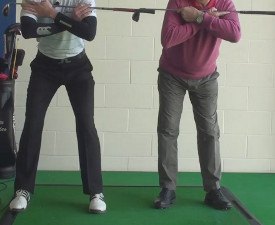
Modern equipment allows older golfers to hit the ball nearly as far as they did as younger players. In some cases, even farther. It's inevitable, however, that we'll lose flexibility and swing speed as our bodies age.
Watch any Champions Tour event and you'll notice that many of the pros, especially those 60 and older, have shorter swings than they used to. In other words, it happens to the best of us – literally.
The good news is, there are ways to maintain and even improve your flexibility at any age. Use this test to determine the state of your flexibility and what you need to work on:
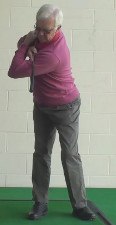
How far could you turn without rotating your hips? How about after freeing the hips?
If you struggle to reach a 90° shoulder turn while allowing the hips to move, try some flexibility exercises. They'll not only help your golf game, you'll feel better too.
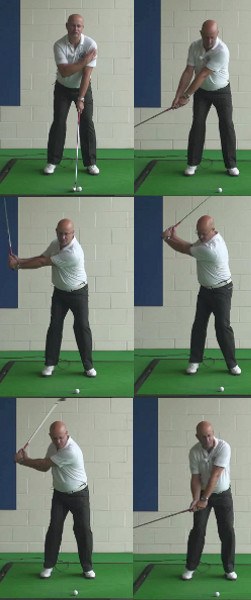
Senior Test Flexibility to Improve Shoulder Turn
Golf is a game for players of all ages. In fact, the ability of the game to appeal to players both young and old is one of the main reasons it has remained so popular throughout the years. If you take up golf at a young age, you should be able to continue playing it throughout much of the rest of your life. The physical demands of the game are relatively low compared to many other sports, so playing golf during your retirement years is a far easier task than playing games like basketball or tennis. As an opportunity to spend time outside with your friends playing a game you love, it doesn't get much better than golf.
With all of that said, there are still some basic physical requirements that you will need to meet in order to play golf. Specifically, you will need to have at least a moderate degree of flexibility in order to turn back and through the shot. Golf is a rotational game, so maintaining some level of flexibility throughout your body is going to be to your advantage. Everybody gets less flexible as they get older, but maintaining your physical fitness to the best of your ability will help you out on the course (as well in the rest of life).
When you maintain flexibility into your senior years, you will be able to keep making a good shoulder turn, which is one of the keys to striking powerful and accurate shots. Many players begin to lose some of their shoulder turn as they get older, which leads to a loss of power and a decreased ability to strike the ball cleanly. To keep your shoulder turn going strong, you actually need to have flexibility throughout your body, not just in the shoulders. Your lower back, upper legs, core, and more all need to be able to help you rotate away from the ball in the backswing. The whole body needs to contribute if you hope to make quality golf swings, meaning your whole body has to be up to the challenge from a fitness perspective.
It is important to note that golfers of all ability levels can benefit from working on their shoulder turn. Whether you are an accomplished player who has decades of good scores behind you, or you are just taking up the game now that you have retired, everyone can gain from making a good turn. There is no reason to give up on trying to make a big turn and a fundamentally sound golf swing just because you have passed age 60 or 70. If you continue to focus on your fitness, and you use the right mechanics in your swing, it is possible to keep playing impressive golf well into the future.
All of the instruction below is based on a right handed golfer. If you happen to play left handed, please be sure to reverse the directions as necessary.

Basics of a Turn
Before worrying about improving your flexibility to make a good shoulder turn, it is important that you understand how to make a good turn in the first place. After all, if your technique is wrong, you might find that it isn't actually your flexibility that is limiting the turn – it could just be the fact that you are going about it incorrectly. Once you check on the status of your technique you can then move on to addressing any flexibility issues that are holding you back.
The following list includes the basic fundamentals of a great shoulder turn. Compare this list to the current state of your swing to ensure you are on the right track.
- Left shoulder starts the action. If you are going to make a good turn, you need to be sure that the turn starts immediately upon the club moving away from the ball. Many players use their hands or arms to start the swing, while the shoulders remain static. Even if you were to get your shoulders started later on, they would never be able to finish the turn correctly because the hands and arms would be too far ahead. As you stand over the ball, focus on starting the swing with your left shoulder. That shoulder should rotate under your chin, which should be up off of your chest at address. Getting this initial move correct is a huge part of making a good turn. Once you have started off correctly, you will simply need to continue with the shoulder rotation until you have reached the top of the swing.
- Supportive lower body. The lower body plays a huge role in the quality of your shoulder turn going back. Many amateur golfers make the mistake of keeping their legs straight at address, which makes it difficult to balance as you attempt to rotate your upper body. You will never strike powerful shots with straight legs, and you will likely have trouble even making good contact. To facilitate a good turn, it is important that you have plenty of flex in your knees at address – and that flex should be maintained throughout the rest of the swing.
- Plenty of time. You will never complete your shoulder turn correctly if you are rushing through the backswing. It is easy to get in a rush on the course, especially if you are feeling a bit nervous about the outcome of the shot. However, if you are going to play the game to the best of your capabilities, you are going to have to learn how to slow yourself down while the swing builds naturally. Use an even tempo throughout the backswing and do your best to avoid rushing into the transition. Only when the club and your shoulders have fully rotated away from the target should you switch directions and head down into impact.
- Freedom in the right leg. Some golf teachers will instruct you to keep your right leg perfectly still during the backswing. While there is nothing wrong with this idea for some players, it will lead to a short backswing for those working with limited flexibility. If you feel like you are unable to make a good turn while keeping that right knee in place, feel free to let it move a little bit out to the right during the backswing. You don't want to let the right leg sway so far right that you lose your balance, but a little bit of movement isn't going to do serious damage to your swing. Rather, it should help your swing overall because you will be able to turn your shoulders back farther as a result of the freedom you have given that leg.
During your next trip to the driving range, evaluate the current state of your shoulder turn based on the four points above. Are your mechanics in good condition, or do you need to put in some work to whip your swing into shape? Most likely, you will need to improve on one or more of the points above. Once you have tightened up your mechanics to a point that you feel is satisfactory, you can then move on to focusing on the role that flexibility plays in your swing.
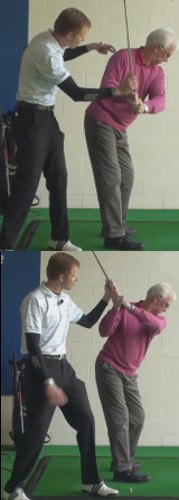
Getting Help
It is never a good idea to go into a fitness regimen without some assistance from a professional. Sure, you could just head out on your own to start working out, but the results would likely fall short of your expectations (and you could hurt yourself in the process). Always consult with a doctor before you get started with any kind of new exercise, and strongly consider working with a personal trainer after you have the doctor's approval.
If you decide to seek the help of a trainer in order to get your body ready to play great golf, look for one that has a specific focus on sports fitness. While all trainers will be able to help you get into better shape, those who are focused on sports will understand the specific movements that each sport demands from its athletes. In this case, you will want to find a trainer who is at least basically familiar with the game of golf. To get the maximum benefit from your effort in the gym, it is important that your workouts are centered on flexibility in the correct areas of the body, and an experienced sports trainer should be able to make that happen.
When trying to gain flexibility as a way of helping your golf swing – and your shoulder turn, specifically – building muscle mass is usually not the goal. Building muscle can actually hurt your golf swing in some ways, as those muscles might get in the way of making a full turn. Think about the players you see on the PGA Tour when you watch a tournament on TV – are they large, muscle bound men? Usually not. Rather, they are generally lean and fit, strong enough to hit powerful shots but flexible above all else. You don't necessarily need to get yourself into the kind of physical condition that is seen among the best players in the world, but they can serve as a model for the type of fitness that you are working toward. Lean muscle, a healthy weight, and plenty of flexibility will lead you to the best golf swings of your life.
As you are looking for a trainer to help you reach these goals, make sure you find one that is willing and able to work with your schedule and needs. The only way you are going to stick with a fitness routine is if it is convenient for you – so make sure nothing about the process is a hassle that will cause you to give up on your goals. The trainer should be located relatively close to your home, they should have a schedule that fits nicely with yours, and they should offer rates that fit in your budget. In many ways, deciding on a trainer to help you with your golf fitness goals is the same process as hiring a golf teacher to help you with your swing. The relationship needs to work for you if the outcome is going to be a success, so don't make your selection until you are sure you have found the right option.
To recap, make sure you consult with a doctor before getting started on any kind of work out program. Once you have done that and been given permission to start working out, look into finding a personal trainer who can help you tailor your exercise specifically for golf purposes. A good trainer will understand which parts of your body need to be flexible in order to make a good swing, and they will customize a workout routine for those needs. Golf is a game that is never going to be easy, but it certainly can be made a little easier when you have fitness and flexibility on your side.
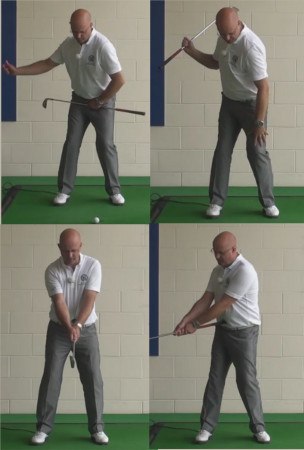
Adjusting to Your Improved Turn
At this point, we are going to 'fast forward' a little bit and assume that you have done the work to improve your flexibility and you are now making a much bigger turn. That's great! However, you might be frustrated to find that your golf swing, and your results on the course, are not as excellent as you might have expected. Despite making a bigger turn, you may still be shooting the same scores, or even worse, than you were before you focused on your fitness.
So what is going wrong? Most likely, you need to make a few technical adjustments to account for the added rotation that is taking place in the backswing. You swing has changed dramatically as a result of your improved turn, and you are going to need to spend some time on the practice range to get everything back in the right order. Fortunately, it shouldn't take too long to get back on track. Work on the following points and your ball striking should come around in short order.
- Fix your timing. Over the years, you have gotten used to the timing of your swing with a short backswing in place. Now that your turn away from the ball is longer, your swing is going to take longer to complete. That isn't a problem necessarily, but it is a change that you are going to have to adjust to before you can play your best. The best way to learn the timing of your new swing is simply to hit as many balls as possible. With each shot you hit, your body will get more and more comfortable with the timing that needs to be used to create a clean strike. It is not a good idea to try to find this timing out on the course, either – you should work on this element of your game on the range so that it is in place when you walk to the first tee.
- Watch your balance. Making a longer backswing is a great thing as far as generating power is concerned, but it can cause trouble when it comes to your balance. A longer swing has the potential to pull your weight onto your right side – and it is hard to recover once you start to lean out onto your right leg. As you turn back, make sure your weight is staying centered within your stance. Good balance is the key to hitting solid golf shots, and you don't want your improved flexibility to rob you of this important fundamental. Go ahead and use your flexibility to make a long swing, but make sure not to lose track of your balance at the same time.
- Engage your lower body. The downswing should be all about your lower body. Good golfers use their hips to rotate the body through the shot, while the club lags behind and builds speed all the way up until impact. With a longer swing, you might fall into the trap of using only your arms in the swing. Many amateur golfers make the mistake of keeping their legs still while the arms swing back and through. You might be able to strike some decent shots this way, but you will never have the kind of power that you could create if you used your legs. Make sure your hip rotation is starting right from the top of the swing so you can be swinging as fast as possible when the club reaches the ball.
There will be a period of adjustment required to get your game on track anytime you make changes to your swing. Now that you are making a longer swing thanks to better flexibility, you are going to need to invest some time on the range in order to sort out the details and bring it all together nicely. Once this work is done however, you will likely be left with some of the longest and straightest golf shots of your life.
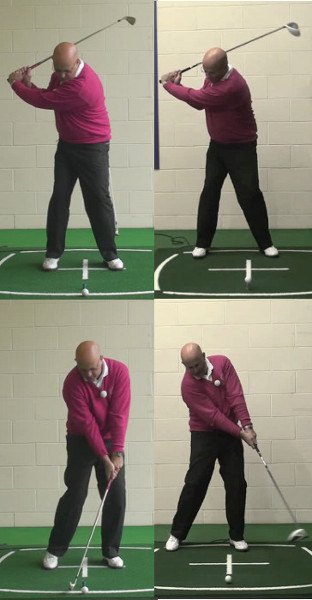
Keeping Golf Fun
It is a great idea to pursue opportunities to maintain the quality of your game as you move into your senior years. Golf is one of the rare sports that allows its participants to keep playing well into the retirement age – long after those same people would have to have given up playing other, more physical sports. If you keep yourself in good physical condition and practice your game regularly, you should be able to hit good shots and shoot good scores for many years ahead.
With all of that said, you also need to make sure you are keeping the game fun without placing too much emphasis on the exact score that you shoot each round. Golf is supposed to be a game, and it is supposed to serve as entertainment and exercise – not stress. If you find yourself worrying too much about the state of your game as the years go by, you may lose track of having fun with your friends on the course. If the game isn't fun, there is no point in playing, and you will probably soon find yourself looking for other things to do.
One of the keys to having fun on the golf course is keeping the game in perspective. Would you like to shoot a good score? Of course. Is it a big deal if you don't? No, not really. Your priority should be to have fun while enjoying the time spent with your friends. That doesn't mean you should give up on playing good golf, but there is a balance that needs to be struck between your competitive side and your social side. Relax while you are on the course and appreciate the opportunity you have to play this great game.
As we get older, all of us lose a little bit of our athletic ability. There is no shame in having your golf game slowly decline as the years go by – it happens to everyone. If you let that gradual decline affect the amount of fun that you are having on the course, you will be missing out on a great chance to enjoy one of the most-popular leisure activities for seniors. Sure, you might not be able to hit the ball quite as far as you used to, but so what? Do your best, have fun along the way, and remember all of the great shots you have hit through the years.
Flexibility is one of the most-important physical attributes for golfers of all ages, and that certainly applies to seniors. If you are moving into your retirement years and you would like to maintain the quality of your golf game for as long as possible, be sure to address your level of fitness with a professional (after getting permission from your doctor, of course). The game should always be about fun first and foremost, but there is nothing wrong with continuing to work on your game in order to play up to the best of your ability.






